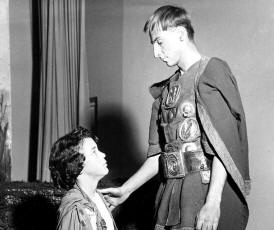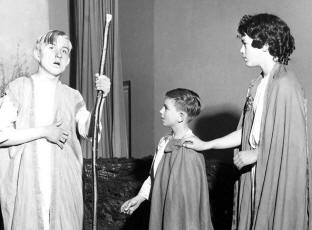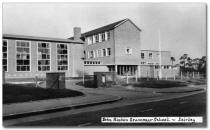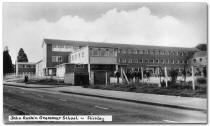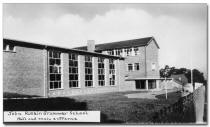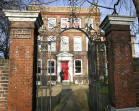|
Bob Wane (JRGS 1945-53) unearths a fascinating image from a Fifties school trip ... |
|
Bob Wane, Bedford, Beds August 2009 Email John Byford (JRGS (1959-66) adds: The picture may well have been taken by the River Seine in Paris, between the Pont de la Tournelle and Notre Dame; these steps lead up to the Quai de la Tournelle. |
|
David Preston (JRGS 1968-75) recalls Seventies school life and the Mill Fairs... |
|
David Preston, Brisbane, Australia. August 2009 Email |
|
Paul Graham (JRGS 1959-66) recalls the 1962 production of Julius Caesar... |
||||
|
I have unearthed two interesting images from the Senior School Dramatic Production of Julius Caesar that was staged in December. 1962. The producer was Mr. Crowe. Click on either thumbnails to view a larger version.
A review of the production can be
found in the April 1963 School Magazine on pages
12 and
13. At the
time of its staging, I was in 3U, while David Treleaven was in U6 and
the school vice-captain. David Orange was in Year 2. I had
played opposite John George (as Portia and Shylock) earlier that
year in April's Junior School Dramatic Production. Paul Graham, Iver, Bucks, August 2009 Email |
|
Richard Winborn (JRGS 1961-68) cannot make the Reunion but recalls school life... |
|
I recently found out about the
Ruskin Reunion and
The Mill website from Lance Goodman, who was a year above me.
Unfortunately, I cannot make the event, as I have another engagement on
5 September, but please pass on my best wishes to Martin Nunn,
who taught me RI and whom I also knew through the Croydon Schools Camps. Richard Winborn, London SE19, August 2009 Email |
|
Geoff van Beek/Downer (JRGS 1962-69) unearths some interesting postcards... |
|||
|
A couple of years ago I discovered that the sweetshop just up the road from the former JRGS site in Upper Shirley Road, next to The Sandrock pub, still has nostalgic monochrome postcards of the school. They are not on display - more of an "under-the-counter" thing now!
Click on any thumbnail to view a larger version. Click here for a medium or here for a large combined version. Geoffrey C. van Beek, Rotterdam, Holland, August 2009 Email. |
|
Mel Lambert (JRGS 1959-65) spots a famous Croydon landmark: Ruskin House... |
||||
Mel Lambert, Burbank, California, August 2009 Email |
||||
| Geoff van Beek/Downer (JRGS 1962-69) fondly recalls a former schoolmaster... |
|
The upcoming
Ruskin Reunion in September
has prompted me pass on my regards to a few of the people whose names I
recognized on the list of participants. I would also like to write to
former schoolmaster Charles Smith via The Mill site, which is all
we have left of JRGS. Geoffrey C. van Beek, Rotterdam, Holland, August 2009 Email. |
|
Mike Marsh (JRGS 1949-55) recalls a 1953 school trip to Switzerland... |
|
Photographic origins in
late-Forties Mike Marsh, Great Cornard, Sudbury, Suffolk, August 2009 Email Bob Wane (1945-53) adds: I was on that same school trip to Aeschi in 1953. It would have been at Easter, if only for the reason that I left JRGS that summer. |
|
Archived News/Events Pages have been moved here. |
|
The content of this web site is provided for educational purposes only, and is subject to change without notice. The JRGS Alumni Society makes no representation about the accuracy, reliability, completeness or timeliness of the content of this web site, nor the results to be obtained from using any part of such content. |
Please send any messages and memorabilia to
webmaster
©2026 JRGS Alumni Society. All
Rights Reserved. Last revised:
07.12.25

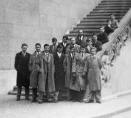
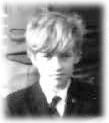 I
appear in the
I
appear in the 